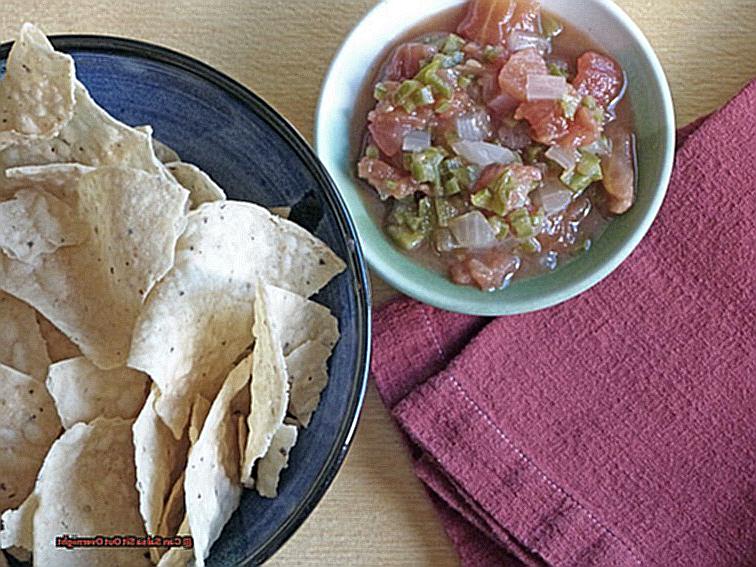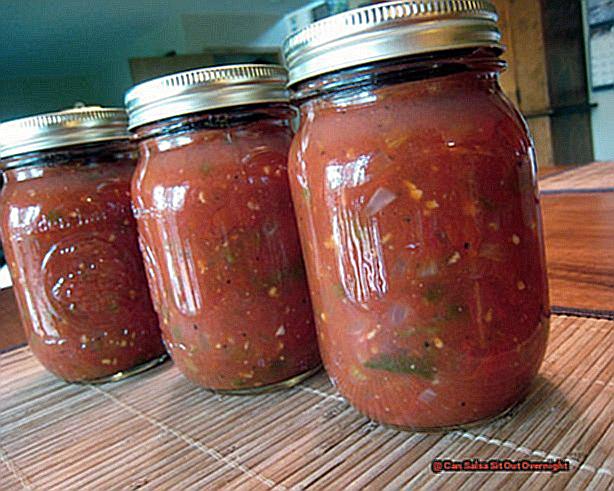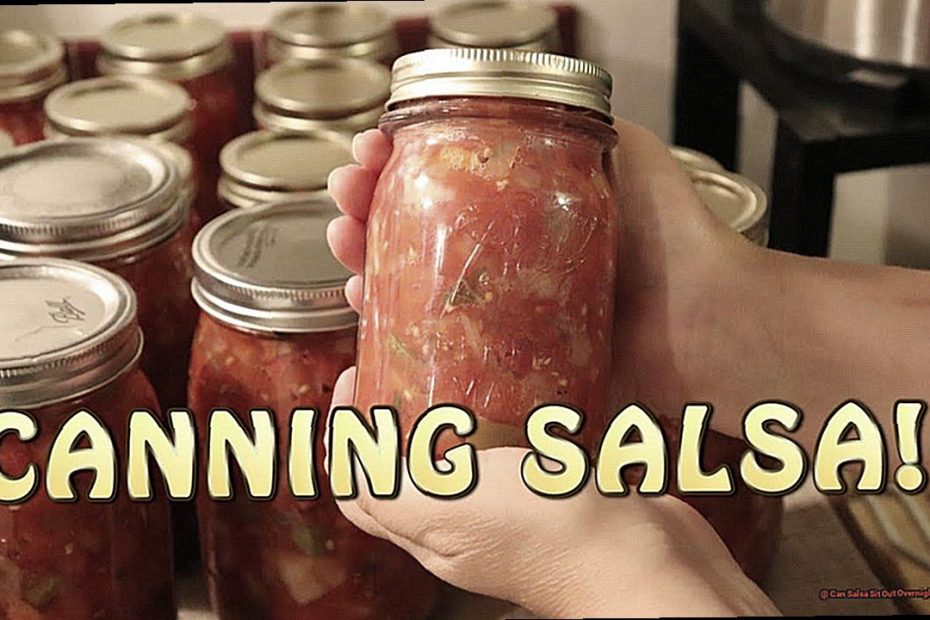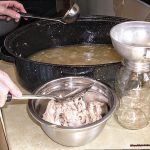Have you ever found yourself leaving a bowl of salsa out overnight? It’s a common mistake that many of us have made, especially after a night of snacking or hosting. But what may seem like a harmless oversight can actually have serious consequences.
Leaving salsa out at room temperature for an extended period of time can lead to food poisoning and other health risks. Here’s why:

- Bacteria growth: Just like any other perishable food, salsa needs to be stored properly to prevent bacteria growth. Leaving it out for more than two hours allows harmful bacteria to multiply quickly, putting you at risk for foodborne illnesses.
- Loss of flavor and texture: Not only does leaving salsa out pose health risks, but it also affects its taste and texture. The heat and humidity can cause the ingredients to break down, resulting in a watery and unappetizing mess.
- Cross-contamination: If you’ve used your salsa as a dip for chips or veggies, there may be leftover bits of those foods in the jar. Leaving it out exposes it to potential cross-contamination from other foods or surfaces.
Don’t let this simple mistake ruin your love for this beloved condiment. Remember these key points and always refrigerate your leftovers promptly.
Contents
- 1 Key Takeaways: Store Salsa Overnight
- 2 Can Store-Bought Salsa Be Left Out? Know The Easy Ways
- 3 Can You Leave Salsa Out Overnight in the Kitchen? The Most Usual Answer
- 4 Are Store-Bought Salsa Cans Unrefrigerated? Things You need to know
- 5 How Long Does Uncanned Salsa Last in the Fridge?
- 6 How Long is Salsa Good for Unrefrigerated?
- 7 How to Store Salsa by Canning? Steps You need to follow
- 8 A Homemade Salsa Recipe: Know The Preparation
- 9 Conclusion
Key Takeaways: Store Salsa Overnight
Storing salsa overnight can have both positive and negative impacts on its safety for consumption.
Positive effects:
- Putting salsa in the fridge overnight can aid in maintaining its freshness and preventing the growth of harmful bacteria.
- If you plan on enjoying your salsa within 3-4 days, storing it overnight in the fridge is a wise choice.
- It allows the flavors of the salsa to blend and intensify, resulting in a more delectable taste experience.
Negative effects:
- Leaving salsa at room temperature for more than 2 hours before refrigerating it overnight can make it unsafe to consume.
- Bacteria thrive in moist and warm environments, which can lead to food poisoning if consumed.
- Freezing already old salsa may not be safe as the bacteria may have multiplied to dangerous levels.
Signs that storing salsa overnight has impacted its safety for consumption:
| Signs | Description |
| Changes in texture | Salsa may become slimy, watery or grainy in consistency. |
| Off odor | Salsa may emit a sour, rancid or fermented smell. |
| Discoloration | Salsa may change color, such as turning brown or green, indicating spoilage. |
| Sour or rancid taste | Consuming spoiled salsa may result in a sour or unpleasant taste in the mouth. |
| Fuzzy mold | Mold growth on the surface of salsa is a clear indication of spoilage. |
| Bacterial growth | In severe cases, salsa may exhibit signs of bacterial growth, such as bubbling or gas production. |
And, storing salsa overnight in the fridge can be safe for consumption if done correctly. It is crucial to store salsa properly and consume it within a few days to avoid any potential health risks. Always check for signs of spoilage before consuming salsa to ensure its safety. If you are uncertain, it is best to dispose of the salsa to prevent any potential food poisoning.
Key Takeaways: Store Salsa Overnight
Storing salsa in the fridge overnight can help preserve its freshness and prevent bacterial growth, resulting in a more delicious taste experience. However, it is important to properly store and consume salsa within a few days to avoid any potential health hazards. Always check for signs of spoilage before consuming salsa and discard it if you are unsure.
Can Store-Bought Salsa Be Left Out? Know The Easy Ways
The answer is no. Salsa, with its high moisture content and ingredients like tomatoes, onions, and other vegetables, is considered a high-risk food that can quickly spoil. Bacteria thrive in moist environments, making it unsafe to store salsa at room temperature.
To ensure the freshness and safety of your store-bought salsa, it is best to refrigerate it at 40F. When stored correctly in an airtight container at the back of the fridge, salsa can last for 3-4 days before starting to spoil.
While freezing can prolong the shelf life of salsa, it may affect its taste and texture after thawing. To prevent ice crystals from forming and changing its texture, reduce the salsa’s water content before freezing.
It is crucial to pay attention to any signs of spoilage when consuming store-bought salsa. Changes in texture, odor, slime or discoloration, and a sour or rancid taste are all indicators that the salsa has gone bad. In such cases, do not consume the salsa and discard it immediately.
It is worth noting that commercially canned or jarred salsa may contain preservatives that allow them to be stored at room temperature before opening. However, once opened, all types of salsa should be refrigerated and consumed within a few days.
In conclusion, to ensure the freshness and safety of store-bought salsa, it is best to refrigerate it immediately and consume it within a few days. Freezing can also prolong its shelf life, but proper attention to signs of spoilage and storage methods is necessary to maintain its quality.
Can You Leave Salsa Out Overnight in the Kitchen? The Most Usual Answer
No, it is not advisable to leave salsa out overnight in the kitchen.
Leaving salsa at room temperature for an extended period can create an ideal breeding ground for bacteria, leading to potential food poisoning. Salsa is a high-risk food due to its moisture content and ingredients such as tomatoes, onions, and other vegetables that can spoil quickly. These conditions provide the perfect environment for bacteria to thrive and multiply, making it unsafe for consumption.
It is recommended to store salsa in an airtight container in the fridge for 3-4 days to maintain its freshness and safety. After this time, it is best to discard any remaining salsa. Freezing salsa is also an option, but it may lose some of its flavor over time.
If you notice any changes in texture, smell, or appearance of the salsa, it is best to dispose of it immediately as it may have gone bad. This applies to both homemade and store-bought salsa.
Commercially made salsa may contain preservatives that allow it to be stored at room temperature until opened. However, once opened, it should be refrigerated to prevent spoilage.
In conclusion, leaving salsa out overnight in the kitchen is not recommended. Proper storage and paying attention to signs of spoilage are essential in maintaining its quality and safety.
Are Store-Bought Salsa Cans Unrefrigerated? Things You need to know
Absolutely not, it is not safe or advisable to consume store-bought salsa from unrefrigerated cans after leaving it out overnight. Salsa is a perishable food that should be refrigerated immediately after opening or making.
Allowing it to sit at room temperature for an extended period can create the perfect breeding ground for harmful bacteria, which can ultimately lead to food poisoning.
The table below demonstrates the recommended storage times for various types of salsa:
| Type of Salsa | Refrigerated Storage Time | Unopened Shelf Life |
| Fresh salsa (homemade or store-bought) | 3-4 days | N/A |
| Canned salsa (unopened) | N/A | 6-8 months |
| Canned salsa (opened) | 2 hours (uncovered) | N/A |
As evident in the table, fresh salsa has the shortest refrigerated storage time compared to canned salsa. This is due to the fact that fresh salsa does not contain any preservatives and is more vulnerable to rapid spoilage. It is crucial to pay close attention to the “best by” date on store-bought salsa and dispose of any remaining portions after 3-4 days of opening.
If you happen to leave a can of opened salsa out overnight, it is best to discard it as it may have already been exposed to harmful bacteria. Even if the salsa appears and smells fine, it is always better to err on the side of caution when dealing with perishable foods.
It is imperative that store-bought salsa be refrigerated at all times after opening or making. Allowing it to sit out overnight can result in foodborne illness and should be avoided at all costs.
How Long Does Uncanned Salsa Last in the Fridge?
Uncanned salsa typically lasts for 5 to 7 days in the fridge, but this may vary depending on the ingredients and freshness. To avoid any potential food safety risks, it is important to discard it after this time and use your best judgement when consuming.
To ensure the longest shelf life for your salsa, proper storage methods are key. Here are some tips for storing uncanned salsa in the fridge:
- Opt for airtight containers: Mason jars or glass containers are great options for storing your salsa as they prevent air and moisture from reaching it, keeping it fresh for longer.
- Label with the date: To keep track of when your salsa was made or purchased, label the container with the date. This will help you know when it should be consumed by.
- Refrigerate always: Whether store-bought or homemade, always refrigerate your salsa. Leaving it at room temperature can lead to bacterial growth and spoilage.
- Check for spoilage: Before consuming, always check for any signs of spoilage such as mold, unusual smells, or discoloration. If you notice any of these, discard the salsa immediately.
If you have a large batch of salsa that won’t be consumed within 5 to 7 days, freezing is an option for preserving it for up to six months. Cooked salsas tend to maintain their texture better after being defrosted compared to raw ones.
In conclusion, properly storing uncanned salsa in the fridge is crucial for maintaining its freshness and flavor. Remember to use airtight containers, label with the date, and always refrigerate.
How Long is Salsa Good for Unrefrigerated?
Salsa, a popular Mexican condiment, is created with fresh ingredients like tomatoes, onions, peppers, and cilantro. Because of these natural ingredients, it is prone to spoilage if left out for an extended period. The general rule for perishable foods is to not leave them at room temperature for longer than two hours. However, there are several factors that influence the shelf life of salsa, including the acidity and salt content of the ingredients, as well as the storage conditions.
Factors that affect the shelf life of salsa:

- Acidity: The acid content in salsa helps to preserve it and keep it safe to eat for a longer time. Salsas made with high-acid ingredients like vinegar or citrus juices tend to last longer than those without.
- Salt content: Salt acts as a natural preservative for food and can help extend the shelf life of salsa.
- Temperature: Bacteria grow rapidly in warm temperatures, so leaving salsa out in a hot room or outside can cause it to spoil quicker.
How long is salsa good for unrefrigerated?
Homemade salsas with high acid content can be kept at room temperature for up to 48 hours if stored properly in an airtight container. However, store-bought salsas may only last up to 24 hours outside of the fridge due to their lower acid content and added preservatives.
Signs that salsa has gone bad:
- Mold: If you see any visible mold on your homemade salsa, it has gone bad and should be discarded.
- Discoloration: If your salsa has turned brown or darkened in color, it may be a sign of spoilage and should not be consumed.
- Off smell: If your salsa smells unpleasant or off, it is best to throw it away.
How to properly store salsa:
To ensure that your salsa stays fresh and safe to eat for as long as possible, here are some tips on how to properly store it:
- Refrigerate immediately: As a precaution, always refrigerate your salsa as soon as possible to prevent bacterial growth.
- Keep it sealed: When storing salsa, make sure it is in an airtight container to prevent any contamination.
- Avoid double-dipping: Repeatedly dipping into the same jar of salsa with a used utensil can introduce bacteria and reduce its shelf life.
- Check for spoilage: Before consuming your salsa, make sure to check for any signs of spoilage, such as mold or discoloration.
In conclusion, salsa should not be left out for more than two hours at room temperature and should be refrigerated immediately after use. Homemade salsas can last up to 48 hours outside of the fridge if properly stored, while store-bought salsas may only last 24 hours.
How to Store Salsa by Canning? Steps You need to follow
Canning salsa for long-term storage requires careful attention to detail to ensure the safety and quality of the food. These crucial steps include preheating jars, preparing the salsa recipe, filling jars with salsa, removing air bubbles, wiping the jar rims, processing in a canner, and checking the seal. Let’s take a closer look at each step.
Preheat the jars
To prevent jars from cracking during the canning process, it’s important to preheat them before filling them with salsa. This can be done by placing them in a large pot of simmering water for a few minutes.
Prepare the recipe
Begin by roasting your tomatoes, removing their skins, and chopping them before adding other ingredients like onions, peppers, and spices to create your desired salsa recipe.
Fill the jars with salsa
Carefully fill each jar with the prepared salsa, leaving about ½ inch of headspace at the top to allow for expansion during processing.
Remove air bubbles
Use a non-metallic utensil to gently remove any air bubbles that may be trapped inside the jars by sliding it down the sides.
Wipe the rim
Ensure a proper seal by wiping any spills or residue off the rim of the jar with a clean cloth or paper towel.
Process in a canner
Place the jars in a canner filled with boiling water and process according to recommended guidelines for your specific recipe.
Check the seal
After letting the jars rest for a few hours, check the seal by pressing down on the lid. If it doesn’t move or make a popping sound, the seal is secure.
In addition to following these steps, it’s important to choose appropriate containers made of materials that won’t react with acidic foods like salsa. Labeling containers with important information such as name, date made/purchased, and ‘use-by’ dates can also help keep track of the salsa’s shelf life.
A Homemade Salsa Recipe: Know The Preparation
When preparing a homemade salsa, it is crucial to follow tried and tested recipes that have been deemed safe for canning. This guarantees that the correct levels of acidity are attained for secure preservation. It is advisable to use Roma tomatoes and avoid using tomatoes that have been killed by frost due to their higher acidity levels. It is also essential to refrain from increasing the amount of peppers and onions beyond what the recipe specifies.
To ensure safe consumption, it is best to utilize appropriate preservation techniques such as freezing or pickling, rather than relying on natural preservatives like vinegar or lemon juice. Furthermore, it is recommended to not thicken the salsa before canning, but instead add thickening agents after opening the jar.
When preparing homemade salsa, it is crucial to adhere to tested recipes that have been proven safe for canning. This guarantees the correct levels of acidity for secure preservation. For instance, I once tried to improvise my own salsa recipe and ended up with an overly acidic batch that was inedible.
It is recommended to use Roma tomatoes for their higher acidity levels and avoid using frost-killed tomatoes. I learned this lesson the hard way when I used some frozen tomatoes from my garden and ended up with a salsa that was too watery and lacked flavor.
In addition, it is important not to exceed the specified amount of peppers and onions in the recipe. I once added extra jalapenos to my salsa, thinking it would give it an extra kick, but it ended up being too spicy for anyone to enjoy.
To ensure safe consumption, it is best to use proper preservation methods such as freezing or pickling. I learned this valuable lesson when I tried to preserve my salsa by simply adding vinegar and lemon juice instead of canning it properly. The result was a spoiled batch of salsa that had to be thrown out.
Lastly, it is recommended to not thicken the salsa before canning.
Conclusion
In conclusion, it is important to be mindful of the potential risks associated with leaving salsa out overnight.
While it may seem like a small mistake, it can lead to harmful bacteria growth, loss of flavor and texture, and cross-contamination. To ensure the safety and freshness of your salsa, always refrigerate it promptly after use and consume it within a few days.
Don’t ignore signs of spoilage such as changes in texture, odor, or appearance. It is also crucial to properly store store-bought salsa and discard any leftovers after opening.
By following these guidelines, you can continue to enjoy this beloved condiment without compromising your health.






